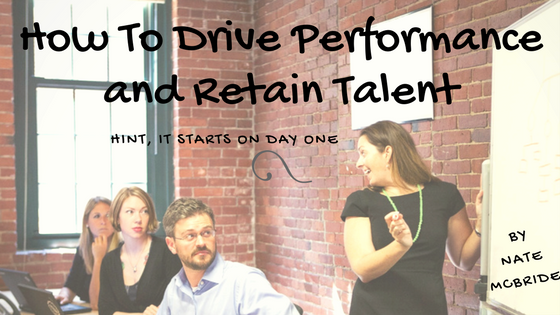Welcome to Assimilation Corp! Today is your first day so we want to make you feel right at home. On the table in front of you, you will find your assimilation packet which includes all of the answers to any questions you have ever had or may have in the future. Do not worry, our auto-empathetic bots have pre-assessed your employee profile to ensure that your every anxiety and concern has been addressed accordingly and that you will be as productive as possible during your stay with us. Please enjoy your stay and do not worry about anything.

Ok so maybe that is a bit unrealistic…except for the worry part. There is a lot to worry about! Start with the fact that the cost to replace an employee is 75% of their salary! If you lose 50 employees a year, we are talking potential millions in LOST dollars and I think that is a low number when you factor in loss of multi-year institutional knowledge. Companies like PeopleProductivehave been able to construct ROI calculators on employee engagement that make you do a double take when you add up the costs of the damage of failed retention.
But this is not an article about retention! Retention does not start at the moment the employee says they want to leave. Retention begins with Day 1, or as it is more commonly known, “Orientation”.
This is an article about that first day.

Is there such a thing as perfect Orientation for a new employee? Probably not although I bet some companies have come pretty darn close. (If you think your company has a flawless Orientation, tell me about it…seriously). In my experience, companies ebb and flow when it comes to improving the Orientation model but, in the end, it usually gets the short end of the stick in terms of time and effort. Why is that?
It is time for Orientation to come out of the dark ages of monochromatic information spewing sessions and catch up to the prismatic cultural forces around it. We need Great Orientations to match the expectations of today’s workforce and lead to better retention numbers and better engagement. Don’t wait until the employee is walking out of the door to play your best song. Open up the show with your encore 21-minute jam!! 
Before we get into this, let’s dissect everything that happened right up to the Orientation…
- A need was identified for a role. The need was carefully considered regarding how that role would positively impact the company. Perhaps it was a new role or a maybe a backfill. Meetings were had, opinions were strongly expressed, a deal was struck. In the end, it was clearly important enough to warrant budget consideration.
- Time was taken to write the job description and iterate it to perfection. Industry comparisons were made, salary models were checked, benefits were calculated and the job was posted online or, if executive level, also with a recruiter.
- The interview process was kicked off and was quite lengthy. Who knows how many candidates came through the door? Senior role? Probably more than one round of interviews with several people. Schedules were changed, resources were booked, disruptions were made. (Significant first impressions moment)
The number of people now vested in the outcome of hiring this role, even if at a tertiary level, now exceeds 15 people.
- A candidate was selected. Let’s take an average number (40 days) to fill the role. 40 days that someone else in the organization had to do that work or maybe the work simply was not getting done. An offer was carefully calculated though perhaps it required a bit of negotiation, especially in a hard to fill role or a senior level position. The offer is agreed upon by all parties.
- The candidate LEAVES their current role with a new start date on the calendar. Their life is as disrupted as it can be. New commute maybe, new culture certainly. Anxiety is the norm for the candidate every day from the moment they said Goodbye to their prior company. Did I make the right choice? I just spent the last two weeks transferring all of my duties, having a tearful goodbye and that final going away party. Damn.
- The start date is circled on the calendar. It is a Monday. They are told to be there at 9am. It has likely been 3–4 weeks since their last contact with the new company beyond an obligatory email with directions and an Orientation schedule.
Now, in your estimation, insert _______ hours and ______ dollars that were spent on this process so far.
Insert _______ days you expect it will take for this employee to be somewhat productive, moderately productive, very productive,
Now, an astute reader will recognize that I skipped the entire prelude section of this process. I purposely skipped the section where months of work are done poorly or not at all which leads UP TO the identified need. That’s for another day when we discuss how it is companies actually arrive at the moment of identifying need.
So now we have a number in our heads of the effort spent just to get one employee in the door. Isn’t it so obvious that we should be killing ourselves on Day 1 to welcome this new perfect person to our tribe?
Fast forward to Monday. Your new hire is excited!! They arrive at your company with renewed career aspirations and great ideas and a desire to do better than their last job. First stop, the processing corral…er….Reception and then on to the Orientation room.
At this point, expectations and excitement levels are still high. After all, the new employee has been through this process before and, at the end of the day, it’s just a process right? There will be millions of processes at the new company. Besides, there are other people in the room whose eyes reflect the same excitement so that must be a good thing.
[three hours or so of presentations occur…fast forward, fast forward]
Lunchtime!! Hopefully the manager has set aside time in their calendar for a quick bite but hey, the manager is busy and can not reasonably be expected to be there, even after so many weeks of waiting and hours spent cultivating this role.
(Significant first impressions moment):
- Manager shows up on time (or early) and is ridiculously excited to have the new employee here. Maybe they don’t even eat but make sure their new employee is fed well and perhaps even makes time for a quick tour? After all, Orientation can WAIT, because it is time to meet the team and learn where the coffee machine is. Priorities are what matters! (Excitement level still high!! Stoked to be here!)
- Manager shows up on time but is running between meetings. Cursory pleasantries are exchanged, food is inhaled but it is obvious the manager is not excited because they are just so busy and seem distracted (perhaps even annoyed) because this meeting is impacting their day. (Excitement level tremors begin. Is that doubt?)
- Manager does not show up/sends lackey/sends no one. (Excitement level blown apart. Shit, I made a bad decision.)
[eating occurs…nom nom nom]
Lunch is over, back to the holding pen…er…orientation room. On to whichever poor department gets the post-lunch presentation session. Getting the post-lunch presentation slot is like following Nicki Minaj on stage with your kazoo and poodle act. There is a reason why my kids have recess after lunch. Those glazed eyes are not listening to a single…word…you…zzzzzzzzzzzzzzzz.
Incidentally, many of the groups that have to present information during Orientation do have very very important things to say. Not all but many. And of course, the people that are charged with conducting the orientation have been HAND PICKED from each function due to their amazing teaching skills, demeanor, patience, experience and love of the company. OR…they were the least busy that day…OR…they are the lowman on the totem pole…OR…they lost a bet.
Regardless, these people are reading the same decks every week to a new herd…er…class and it is just so damn difficult to read the same information every week and be excited about it. This is in alignment with my theory as to why drill sergeants yell a lot. It’s groundhog day on 8 week cycles for them. Translate that into a weekly event… 
I know it sounds far fetched but think about the effect that bad presenters/dry material have on an audience. Now magnify that by 7 or 8 bad presenters/dry decks in one day. It can be an excitement killer but more importantly, it IS PRECISELY an indicator of how much the company cares about these new people.
If you think on it, besides the excitement level and content of presentations, there are of hundreds of first impression indicators throughout that critical first day that each play a role in demonstrating how much the company cares. From the moment a new employee exits their car to the moment they get back into it, their day is filled Significant first impressions moments.
So what can we do better?
Well, picture your first day. Think about what you would have done differently if the choice was yours. Was it an amazing day? Why or why not?
This Orientation overhaul begins with everyone in the organization. Even non-managers can play a part. That new person is joining your functional area so make them feel at home! Imagine how good that will make them feel and how good you will feel by doing it. Decorate their cube, get them a gift, do something because while it make take a few minutes out of your day, it is a moment that they will most definitely remember.
Don’t throw the book at them in Orientation. Give them a long term plan that STARTS with Orientation. Give them expectations for the first 90 days and then track their progress. Meet regularly, if not daily, to make sure they are adjusting to culture and know where to get the best tacos in town. At the very least, check in a few days after Orientation and go over, in brief, everything that was already covered just to make sure. A new employee might not want to be the first person to stand up and say, I lost track of what was happening.
Be there for them when they arrive on Day 1 and then be there for them at any break in the day. Get them things…sodas, water, coffee…whatever. What is to stop you from emailing them in advance of Day 1 and maybe say something like “Hey what is your favorite coffee?” or “Do you have a particular snack you like?”. What will it take you, an additional 30 seconds at Dunkin Donuts to get the coffee for them?
Grab them away from the building and take them somewhere for lunch. Hell bring the whole team while you are at it. Why not? The more you can open up your arms and embrace them the more the will get back in that car at the end of the day and feel amazing about what happened. Further, they will come back on Day 2 feeling like they made the RIGHT decisions.
Make Orientation fun and rewarding for everyone. Do some silly games or something totally irreverent that the new employees are not expecting. Reward the employees who are PERFORMING the Orientation. Incentivize them to be awesome and go after employees who you know will deliver an energizing performance. Get rid of the deck-readers…in fact get rid of the decks! Make it immersive and participatory.
Some easy google searching has shown me that there are lots of companies out there who have constructed unique and very innovative activities for Orientation (like here and here). Have they nailed it? I don’t know exactly, but what IS obvious is that they are making efforts to match the Orientation experience to the culture and that leads to retention and they are proving it and stealing your employees.
-Nate
PS
This could have been an article about tracking employees from Orientation through their career (a la ATS system) but it’s not and maybe some day I will write that.
This is also not an article about Orientation for employees that became employees through acquisition. I will write that one later.
Nate is a 2017 Finalist for Boston CIO of the Year. Recognized industry thought leader with 18 years of experience in the Life Sciences industry and a leading cloud evangelist. A C-Suite leader with the ability to communicate to power and project teams at a level that garners respect coming from hands on experience. He has expertise in all aspects of IT including cybersecurity, digital transformation, application development, CRM & ERP integrations, database design and enterprise wide implementations of hardware and software solutions. Nate understands the value of talent management and the importance of culture to organizations.
From the team at PeopleProductive
We're thrilled to have your interest in our work and we invite you to join our mission of creating work places where the people as well as the company, both flourish. We welcome your support and participation. To find out more about this just reach out to us here!"


